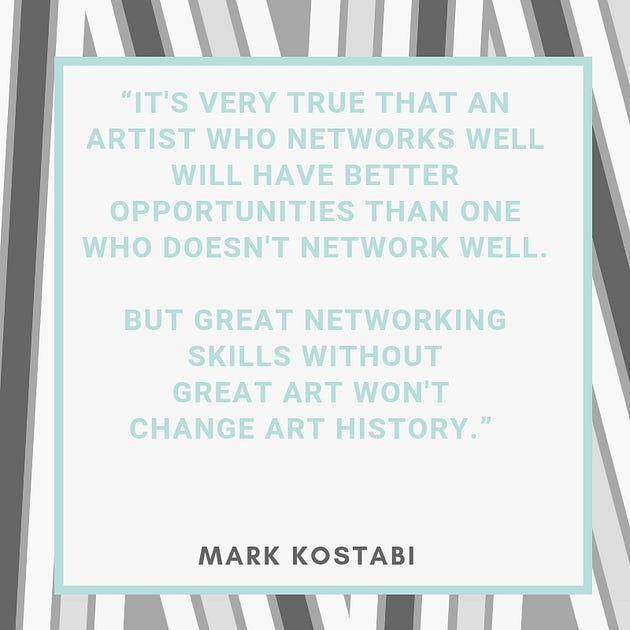5 Things They Don’t Tell You About Life After Art School
Art school is a joyous time in the lives of many artists.
However, post-graduation dark clouds start rolling in, making everything seem overcast and gloomy.
To make matters worse, graduates are often dogged by unwanted opinions on how their creative degrees will do nothing to prepare them for the real world nor set them up with a stable 9–5 job.
In our current climate of soaring rents and overwhelming student debt, young graduates have a hard time, and this is only adding extra pressure.
The one emotion fresh art-school graduate experience is anxiety.
Can I really make it? What do I do now? All my friends are getting jobs making $70,000 a year. Where does that leave me?
So, if you are coming to the end of a creative course or considering applying for one, it’s so worth listening to the pearls of wisdom from the artists and makers who have graced the art school halls before you.
Let’s look at five things nobody tells you in art school about your life after you graduate.
1. Good grades don’t matter in the art world
Many students go to art school to become a better artist or to get a job in the creative industries. Traditionally, a better education leads to a better job, however, the same rule does not apply to the creative industries.
Potential clients, companies, galleries or other creatives don’t care if you have a BA, MA or PhD. They only care about your skills.
Postgraduates often struggle to find a job or sell their work. They will then further their education and feel disappointed if they are still left without a job or sale afterwards.
Unfortunately, no school is going to make you better.
Regardless of which path you take, you have to put in many hours of practice. If you want to be a good painter you have to paint a lot.
Good marks rarely translate to being the best, but if you work tirelessly on your skills you can be the best.
2. Expect frugal days ahead
Do you think life’s hard when you’re a student?
Wait until you get into the real world and you’ll discover what being skint really means.
This can be very disheartening, especially if your friends are getting jobs with a good regular income.
With increasing competition, and spiralling debts, the pressure is endless, and for some, the first year after graduation is a difficult time.
If you’re looking at tuition fees and then think about how much you can expect to earn you’ll see how hard it can be to pay off your student loan.
In the UK tuition fees trebled from £3,000 to £9,000 a year. Add living costs and you’re looking at £20,700 a year or £62,100 for a three year — bachelor’s degree.
In the US the most hotshot art schools will be $100,000 to around $200,000 for three-four years often including accommodation.
Throughout my studies, I was able to work full time. For instance, freelance work not only helps with student fees but also prepares you for the real world.
In the UK you can go to University from the age of 17. Too young to have a drink at a bar yet old enough to make a huge financial decision.
Whatever path you take, a clear understanding of any course fees goes a long way.
3. Selling your art is a cut-throat business

It’s heart-breaking to watch students in their final year realising that they are not even close to good enough. Students have three to four years to refine their skills and this realisation often does not come until they actually talk to industry professionals.
The problem could be the teaching standard at the school.
If you have a mediocre teacher who keeps telling you that your work is pretty good you’ll start believing this.
However, if the market is not responding to you, you are forced to view your portfolios with fresh eyes.
This can feel like your whole world is going to collapse.
If you send a weak portfolio to a gallery you will be ignored.They will only pick the best and consider people who they think have potential.
Do you want to be the best and stand out from the crowd?
Practise, practise, practice.
Spending 4 to 5 hours learning and improving your skill every day is nowhere near enough.
Your competitors are spending twice that.
It’s a very tough market and if you don’t put in the hours you might end up working in a completely separate field.
Think about all the motivated artists wanting to get into the same gallery as you do.
They are willing to put in 14 hours a day.
To give yourself the best possible chance you should probably do the same.
No amount of natural ability can compete with diligent practice.
Your Moment is Now. Be featured in our Interview with Artists series and share your inspiring story!
4. Universities don’t teach you how to build an art career

Saying goodbye to the familiar haven of education and the structure of university life can be a real shock to those who don’t have a definite plan.
After graduation, without the support of the university, you’re now one of many expected to make it in the art world.
The first thing to understand is that you’re going to have to pay your dues.
Every starting profession requires this step. The best law student doesn’t leap right into a partnership, he’s expected to start at the bottom and work his way up. For an artist, this step can take time. Embrace the notion that it can easily take five years before you’re working full time.
Figuring out how to turn your talent into a successful careercan take up so much time that there is not a minute left to be creative.
Unfortunately, art school doesn’t demonstrate how active and engaged you need to be; you’ll have to be your own finance, business and marketing manager, as well as a researcher, curator and administrator.
It’s going to be tough.
But what will set you apart from the rest is:
· Your obsession with your art
· How you present yourself
· Your business sense
· Your perseverance
5. Connections made outside the classroom are the key to success

Keep in touch with your peer group. Leaving art college and becoming a professional artist is tough. For instance, when I graduated there was such little support or professional practice events for ambitious artists.
My advice is to stay in touch with your peer group — get together and create a peer critique group to look at each other’s work or put on a DIY exhibition so you can start to get your work out there.Always keep each other informed of opportunities.
Stay up to date with your network. The person who is sitting next to you at school might be helping you to get your first show or sale in the future.
I am a very private person, but I had to make an effort to go out to talk to people in the industry. No matter what kind of person you are it is self-promotion. Networking is key and it goes a long way to practice that at school. Some schools have amazing industry connections, so make use of them.
For your creative work to flourish and gain the recognition you need a network.
There’s a network available to wherever you are. This may come in the form of an online group or a series of events you attend, maybe even one you organise yourself.
There are connections everywhere and plenty of resources are available to those willing to look.
Take action and persevere

What happens after art school?
We all become famous and earn loads of money from making and creating.
Well, that would be nice.
However, you will be completely lost for a while.
It’s true; you will.
But what nobody tells you about life after art school is that everybody is just making it up as they go along.
And you are definitely not the only one approaching tons of galleries and exhibitions opportunities and getting no reply.
The path to true success never runs smoothly.
Be prepared to take things at your own pace and believe in the fact that your career will grow over time with care and intention.
Your dream of becoming an artist will happen through hard work, determination and persistence.
Don’t wait to be discovered. In other words, take control of your own destiny by finding ways to bring your work to the attention of others.



